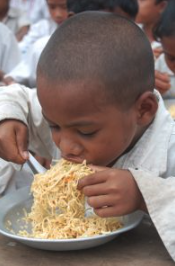by Lori Carlson
We get occasional inquiries about the breakfast program so I thought I’d take some space here to talk about what we spend on food, why we think it’s important, and under what kind of governance it’s distributed.
It’s commonly known that hungry kids can’t learn and there’s no doubt these children are hungry. We have come to see that when children eat nutritious food and drink clean water, their immune systems improve and they stay healthier. Attendance goes up.
They can think!

Koh Ker School Breakfast
We understand these things on an intellectual level, we say “yes of course that makes sense” but when you see it in the day-to-day lives of kids; when you see them feeling better, looking better, doing better, when you see their progress, it resonates in a place that isn’t intellectual anymore.
Nutritious food is important. We can gather up all the children we want to and put uniforms on them and march them off to school, but when their most basic needs for clean water and sufficient food are not being met, then school drops off the priority list pretty quickly. Hungry children will be the first to abandon school.
Most of these children are living in abject poverty. Access to regular meals is often sketchy, usually only consisting of rice, rice with salt, rice with chilis, rice with some broth, rice and more rice with whatever else can be found to put in it. We have had children collapse during flag raising, have found children with vitamin deficiencies so severe that they had lost the use of their legs. We’ve had to take children to hospital for vitamin infusions on several occasions. It is not uncommon for parents to all disappear into the forest to harvest a particular plant or go work on a construction crew for weeks at a time, leaving children at home with no food. Even when parents are home, breakfast is often skipped so available food can be stretched out across the day. These children all also work, like adults, tending fields, fishing, tending livestock, fetching wood and water, the list goes on. Their protein requirements are enormous and it is what’s most lacking in their diet.
All of this to say that when students arrive at school, they are hungry.
Here is the situation at each school:
Wat Bo:
At Wat Bo, the PLF doesn’t support the school per sé because it is very well supported by the community. We do support over 600 children of the urban poor and/or homeless who attend school there. There is no breakfast program in place for these students but we find the urban students tend to do better than the rural ones, having better access to clean water, higher availability of food and ways to work to obtain it, as well as access to medical care.
Tchey:
Tchey School got rations from the World Food Program until 2009 when it cut its breakfast programs all across Cambodia. There are 1000 students at Tchey and we estimated that the breakfast cut profoundly affected probably 150 students. For these, the administration at the school raises money and collects donations from the community at large to provide “Food for Home” for these especially needy children in an effort to encourage them to stay in school. Occasionally when donors are visiting the school, they will bring dry goods to augment this stash of food.
Knar:
The WPF cut the ration at Knar School in 2009 but they continue to get food. Knar gets rice, oil, salt and canned fish. One can of fish is supposed to feed 8 children if you want to get them sufficient amounts of vitamins, protein, etc but at Knar, 40 children are sharing a can. PLF augments the World Food Program ration with loads of fresh vegetables and meat. We often direct food donations to Knar in the form of more fish or other sources of protein and in the afternoons the kids get a snack once a week. We invite visitors to do “Food For Home” food drops at Knar School.
Koh Ker:
At Koh Ker we get the same rations from WFP as at Knar and we feed all 200 children and their teachers 6 days a week, 50 weeks a year. Having breakfast (and clean water) available every day has had a profound effect on the children’s health and well-being. Attendance is very good at the school, largely because of breakfast, and as a result Koh Ker School rates academically as one of the top performing schools in the Province. We often make lunch as well for not only the children, but provide take-home food. It’s been truly phenomenal to see the difference food has made in the children at Koh Ker.

It costs about 14 cents a meal to provide breakfast at Koh Ker. Fourteen Cents.

Recent Comments